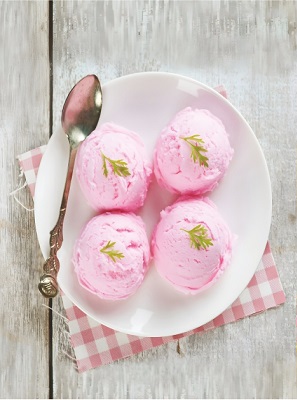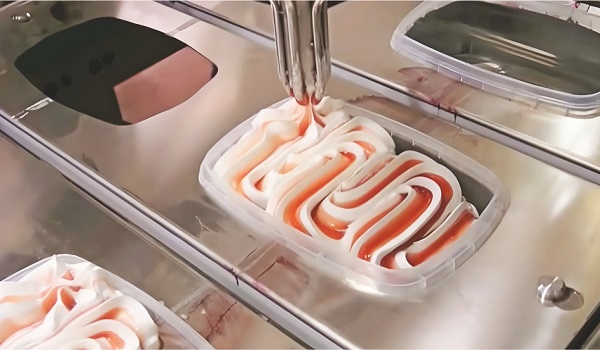Scoops of Success: Mastering the Ice Cream Business
3. The Science Behind Texture and Mouthfeel in Ice Cream
Microstructure of Ice Cream
Under a microscope, ice cream reveals a complex colloid of ice crystals, fat droplets, and air bubbles. The microstructure is pivotal to the texture and quality:
• Ice Crystals: Smaller ice crystals are preferable for a smoother texture. They are typically formed during the rapid freezing phase and are influenced by the types of sugars and stabilizers used.
• Fat Droplets: These are dispersed throughout the mix and partially coalesce around the air bubbles, helping to stabilize the air incorporated during churning.
• Air Bubbles: The distribution and size of air bubbles are crucial. Fine, uniform bubbles contribute to a creamier and lighter texture.
Ice cream, one of the most cherished desserts worldwide, owes much of its unique texture and mouthfeel to the scientific processes of freezing and crystallization.
Understanding these processes is essential for anyone involved in the production of high-quality ice cream. Here’s how freezing and crystallization intricately influence the quality of ice cream:
Freezing Process

The freezing process is the critical phase where the ice cream mix begins to solidify and air is incorporated:
• Control of Ice Crystal Formation: The primary goal during freezing is to minimize the size of ice crystals. Smaller ice crystals are crucial for a smoother texture, which enhances the creaminess and overall sensory feel of the ice cream. This is achieved by controlling the rate and environment of the freezing process.
• Importance of Rapid Freezing: Rapid freezing facilitates the formation of numerous small ice crystals rather than fewer large ones. Quick freezing is vital to prevent the development of coarse, grainy textures that can detract from the ice cream’s quality. Large ice crystals typically form during slow freezing or when the ice cream thaws and refreezes, leading to a less desirable texture.
Crystallization Dynamics
Crystallization in ice cream involves more than just the initial freezing; it includes the continuous management of ice formation:
• Initial Nucleation: This is the initial stage where water begins to freeze forming small nuclei or seeds, which act as the foundation for further ice crystal growth. Rapid and controlled nucleation is essential to ensure that these nuclei remain small and uniform.
• Crystal Growth: Following nucleation, ice crystals begin to grow as the temperature drops and more water freezes. Constant mechanical agitation, or churning, during this phase is crucial. It not only helps in incorporating air but also breaks down potentially large ice crystals, maintaining a uniform distribution of small crystals.
• Role of Ingredients: Certain ingredients directly influence the crystallization process:
o Sugars and sweeteners lower the freezing point of the mixture, which keeps some of the water in a liquid state even at freezing temperatures, thereby controlling ice crystal growth.
o Stabilizers such as guar gum or carrageenan increase the viscosity of the remaining liquid phase, slowing down the mobility of water molecules and thus hindering rapid crystal growth.
Temperature Management
Proper temperature management throughout the production, storage, and serving of ice cream is pivotal:
• Storage Temperature: Ideally, ice cream should be stored at temperatures below -25°C This low temperature ensures that the ice crystals formed during production do not grow larger, which can adversely affect the texture.
• Serving Temperature: Ice cream is best served at temperatures ranging from -12°C to -14°C. At this range, the ice cream is soft enough to be easily scooped but firm enough to maintain its shape, offering an optimal eating experience.
The science of freezing and crystallization is fundamental to crafting ice cream with a smooth, creamy texture. Effective control of these processes, along with meticulous ingredient management and temperature regulation, is crucial for producing high-quality ice cream. By mastering these scientific principles, manufacturers can not only improve production techniques but also drive innovations in ice cream making, ensuring each scoop meets the high standards expected by consumers.
Understanding the detailed interplay between physics and chemistry behind ice cream not only enhances production but also enriches the sensory enjoyment of this beloved dessert.
4.Understanding the Complex Colloidal System of Ice Cream Mix

Ice cream is more than just a delicious treat; it is a sophisticated colloidal system involving multiple phases that influence its texture, stability, and overall quality. These phases include true solutions, colloidal suspensions, and coarse dispersions. Each plays a vital role in the development of ice cream’s creamy texture and structural integrity. This exploration delves into the physical properties of the components in each phase and their impacts on the ice cream mix.
True Solution
In ice cream, a true solution refers to the phase where solutes like sugars and salts are completely dissolved in water, forming a homogeneous mixture.
Components in True Solution:
• Sugars: Sugars such as sucrose, glucose, and corn syrup solids dissolve in the water phase. They provide sweetness and significantly impact the freezing behavior by lowering the freezing point of the mix.
o Sucrose: Commonly used for its balanced sweetness and ability to control the mix’s freezing point.
o Glucose and Fructose: Modify sweetness profiles and adjust freezing points; fructose, being sweeter, allows for a reduction in overall sugar content.
o Corn Syrup Solids: Used to reduce iciness and improve texture; they offer less sweetness but excellent freezing point depression.
• Lactose: Milk sugar, less soluble, which can crystallize and cause a grainy texture if over-saturated.
• Salts: Minor components affecting ionic strength, pH balance, and subtle flavor enhancements.
Role of True Solutions in Ice Cream:
• Sweetness and Flavor: The dissolved sugars are primarily responsible for the sweetness.
• Freezing Point Depression: Both sugars and salts depress the freezing point, ensuring the mix does not freeze solid, aiding in texture smoothness.
• Hydration and Stability: Sugars and salts help hydrate proteins and stabilizers, aiding in forming a stable emulsion and preventing large ice crystal formation.
Colloidal Suspension
Colloidal suspensions in ice cream include larger particles like proteins and stabilizers, which are essential for texture and stability but do not dissolve fully.
Components in Colloidal Suspension:
• Casein Micelles: Protein structures providing viscosity and stability, held together by calcium phosphate in a colloidal suspension.
• Stabilizers: Such as guar gum and carrageenan, which swell in water, increasing viscosity and helping to stabilize the emulsion and control ice crystallization.
Role of Colloidal Suspensions:
• Texture and Viscosity: Increases mix viscosity, contributing to a creamier texture and smoother mouthfeel.
• Emulsion Stability: Helps maintain the emulsion during the freezing process, ensuring uniform texture and preventing separation.
Coarse Dispersion
Coarse dispersions in ice cream refer to larger particles or droplets that are dispersed throughout the mix but remain distinct and can settle over time.
Components in Coarse Dispersion:
• Fat Globules: After homogenization, fat is dispersed as droplets that help to stabilize air cells and contribute to the creamy mouthfeel.
• Other Insoluble Solids: Some additives or particulates may remain in coarse dispersion, affecting texture and consistency.
Role of Coarse Dispersions:
• Creamy Mouthfeel: Fat globules coat air bubbles and contribute to a creamy, rich texture.
• Stabilization of Air Cells: Fat helps stabilize the structure of air cells incorporated during churning, essential for maintaining the ice cream’s body.
Dissolved Whey Proteins

While casein proteins form colloidal structures, whey proteins typically dissolve into the water phase and contribute to the emulsification and stabilization processes.
Role of Whey Proteins:
• Emulsion Stabilization: Whey proteins help stabilize fat emulsions by adsorbing to the surface of fat globules.
• Foam Formation: They play a crucial role in stabilizing the air cells during the whipping and freezing processes, enhancing the texture.
Conclusion
The ice cream mix as a complex colloidal system demonstrates the intricate interplay between various phases, each contributing uniquely to the final product’s quality. Understanding these interactions helps in optimizing manufacturing processes to produce ice cream that is not only delicious but also has the desired texture and stability, reflecting the perfect blend of culinary art and scientific principles.


